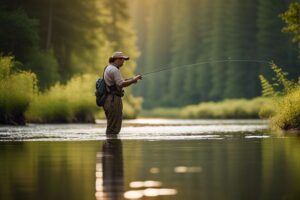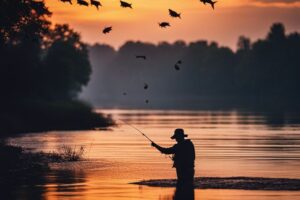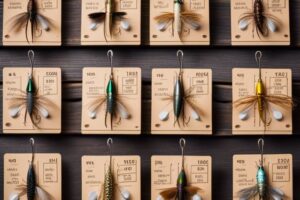Adjusting your leader length is important for mastering different fly types on the water. Whether you’re casting a delicate dry fly or a hefty streamers, the right leader can make all the difference between a fruitful day and frustration. This guide will help you fine-tune your leader to suit various patterns, enhancing your overall success. For more on the foundational elements of fly fishing, check out this Basic Knowledge of Fly Fishing Leaders Cures Beginner … resource.
Dry Flies
The art of fishing with dry flies requires precision and an understanding of how leader length influences your success. When considering presenting these flies on the water’s surface, the right leader can mean the difference between spooking fish and enticing them to strike. You should consider the specific conditions you’ll be fishing in and the behavior of the fish you hope to catch, as these factors will guide your choice in leader length.
Short Leaders for Delicate Presentations
One of the most effective techniques for presenting dry flies is employing short leaders. These shorter lengths—usually in the range of 7 to 9 feet—allow for a more delicate presentation, enabling your fly to sit perfectly on the surface film. The goal here is to mimic the natural movements of insects, and the subtler your approach, the better the chance of success. When casting to rising trout, a short, responsive leader allows you to place your fly precisely where it needs to be, resulting in a more convincing drift.
Moreover, short leaders are less aware of the wind’s whims. They offer greater control when you’re casting near overhanging branches or picky fish that are spooked by excessive line movement. You find that in quiet waters, this precision can lead to a memorable moment: the sight of a rising trout taking your fly with a gentle sip. In these moments, let the water’s surface speak for itself, and trust in the craft of the short leader to do the work for you.
Longer Leaders for Windy Conditions
Flies sometimes behave erratically in the wind, throwing their natural patterns into chaos. In such conditions, a longer leader—typically 9 to 12 feet—proves valuable. This longer line helps to cushion your cast against the gusts, allowing greater separation between your rod tip and the fly. When the breeze is at your back, such a leader keeps your fly afloat longer and helps maintain a natural drift, often catching a fish’s eye despite the surrounding turbulence.
With a longer leader, you can also make casts that extend further from your body, reducing the chances of back-casting problems, and you can reduce splashdown from your fly line. The added length acts like a buffer, isolating your fly from the disturbances above, which is vital when the wind is dancing across the water’s surface. As you adapt your leader length for dry fly fishing, remember that nature teaches us patience and adaptability—the best anglers adjust, just like the water itself.
Nymphs
One of the most effective techniques in fly fishing is the use of nymphs, imitating the aquatic larvae of insects that fish love to eat. Adjusting your leader length to match the type of water you’re fishing is crucial for success. You want to ensure your nymphs are presented at the right depth and in a natural manner. There are key adjustments to consider based on whether you’re fishing in fast or slow water, and whether you’re targeting deeper pools.
Short Leaders for Fast Water
For fast-moving water, shorter leaders are invaluable. They allow for quicker line management and help you maintain better control over your nymphs. With shorter leaders, your ability to react to strikes becomes immediate, which is crucial in turbulent currents where fish may only have a brief opportunity to grab your offering.
A leader length of about 6 to 7 feet is often ideal in these conditions. It minimizes the drag caused by fast currents and can keep your fly in contact with the fish-holding areas more effectively. The quicker you can detect a bite, the more effectively you can set the hook.
Longer Leaders for Slow Water
For slower water, longer leaders come into play. Lengthening your leader to 9 feet or more allows for a more delicate presentation. In calm waters, fish have more time to inspect your nymph, and a longer leader can make your fly appear less suspicious as it drifts naturally with the current.
Utilizing a longer leader gives you the advantage of a more subtle presentation, especially in clear conditions where fish can scrutinize your offerings. This approach can lead to increased strikes, as your fly gently sinks and mimics the natural movement of aquatic life.
It’s important to remember that wind conditions and your casting style also influence the effectiveness of longer leaders. A well-balanced cast can ensure that even in light winds, your line remains manageable, allowing for a steady flow of tension that keeps you in tune with what’s happening below the surface.
Weighted Leaders for Deep Water
For deep water fishing, weighted leaders can be a game-changer. The added weight helps your nymphs sink rapidly, allowing them to reach the fish where they hold deeper in the water column. This method is particularly invaluable in lakes or riffles where fish are not actively rising to the surface.
A weighted leader can be constructed using either pre-wrapped weight or adding split shot to the line. This allows you to adjust the depth at which your nymphs are presented, ensuring they are in the feeding zone rather than floating at the surface.
Fast current situations in deeper waters can pose challenges. You need the weight to penetrate the water while keeping an eye on your line for any subtle bites. The right combination of leader length and weight not only helps you avoid snags but keeps your nymphs moving enticingly through the strike zone, increasing your chances of landing that elusive fish.
Streamers
Your choice of leader length is crucial when fishing with streamers, as different fly preferences can significantly impact your success. Streamers, often used to imitate baitfish and other aquatic creatures, require a thoughtful approach to leader length. The right length will allow you to achieve the desired presentation while ensuring that your fly moves naturally through the water. Knowing how to adjust your leader length can mean the difference between a successful day on the water and an empty hook.
Long Leaders for Big Flies
Leaders that are longer can provide added stealth and finesse, particularly when tossing big flies. A longer leader allows your streamer to sink more appropriately, facilitating a natural drift through the water column. When targeting larger fish with substantial streamers, consider a leader length of at least 9 to 12 feet. This added distance can help keep your fly away from the intrusive line, making it more appealing to wary predators lurking beneath the surface.
Short Leaders for Aggressive Fish
Long leaders are not always the answer. For those times when you are pursuing aggressive fish, a short leader can do wonders for your presentation. A shorter leader, usually around 5 to 7 feet in length, allows for better control of your fly’s action and quicker hook sets, ensuring that you can respond immediately when a fish strikes. When the water is choppy and the fish are aggressive, you’ll find that a short leader can deliver your streamer with the punch it needs to entice those hungry predators.
For instance, when conditions are rough, this shorter setup enables you to manage your cast more efficiently, helping you keep the streamer in the strike zone longer. The increased sensitivity in your setup allows you to feel any nibbles or grabs, ensuring you’re ready to react. Recall, it’s not just about the length; it’s about knowing what the fish want and providing it in a manner they cannot ignore.
Emergers
To successfully navigate the complexities of fly fishing, understanding leader length and its impact on your presentation is key. Emergers, those transitional flies that represent insects just at or below the water’s surface, can require distinct leader adjustments to match their unique behavior. By tailoring your leader length to the fly type you intend to fish, you can achieve a more natural presentation that entices those wary fish to strike.
Short Leaders for Subsurface Fishing
Fishing with shorter leaders when targeting emergers subsurface can often create a more direct connection to your fly, which is vital in presenting subtle movements. A leader length of around 7 to 9 feet can be ideal for this purpose, allowing you to maintain better control over your line without unnecessary drag. This is particularly effective when using weighted nymphs or smaller emergers that don’t require a long drop.
Moreover, shorter leaders help prevent the fly from riding too high in the water column, which can turn off fish that are keying in on subsurface activity. You’ll find that a streamlined approach with a concise leader enhances sensitivity, allowing you to feel the timid takes that are characteristic of fish feeding in slower currents.
Longer Leaders for Surface Film Fishing
With longer leaders, generally ranging from 9 to 12 feet, you can better mimic the natural drift of emergers that often hover in the surface film. This length allows the fly to suspend delicately just beneath the surface, providing a more enticing lie for fish that are looking up to feed. The extended leader facilitates a softer presentation, reducing the likelihood of spooking fish as the leader itself is less visible in the water.
For instance, by using a longer leader, you can make sure your emerger pattern presents just right, subtly drifting with the currents. The key is to maintain a balance between the length of your leader and the weight of your fly. If you opt for a heavier setup, it’s vital to let your fly settle correctly without being pulled under too quickly. This attention to detail can mean the difference between a missed opportunity and a successful catch.
Adjusting Leader Length for Different Fly Types: Terrestrials
Despite the simplicity of catching fish with terrestrials, the nuances of leader length can greatly affect your success. These land-based insects, like grasshoppers and crickets, can bring excitement to any fishing outing. When you target these types of flies, choosing the right leader length is crucial. Short leaders allow for a more direct presentation to the fish, ensuring that your fly lands softly on the water’s surface without much disturbance.
Short Leaders for Hoppers and Crickets
Terrestrials such as hoppers and crickets require a close approach to mimic their natural landing on the water. Using a short leader of about 7 to 9 feet allows you to present these flies effectively without excessive line sag that can turn off wary fish. The key is to maintain control over your cast while also keeping the presentation natural. A short leader helps to reduce drag and brings the fly to life on the surface, inviting fish to strike.
Longer Leaders for Ants and Beetles
The need for longer leaders becomes apparent with ants and beetles, as they often drift downstream with the current. A leader length of 9 to 12 feet works well for these flies, allowing them to drift freely and appear more realistic. This length gives your cast more versatility, letting you present the fly to fish that may be rising farther from the bank. The additional leader length also helps reduce the weight of your line’s impact, adding delicacy to your presentation.
Leaders that are on the longer side can help you achieve a more natural drift, which is vital when trying to catch wary fish while using ants and beetles. The added length allows for subtle adjustments, enabling you to match the rise of the insect on the water’s surface more effectively. With the right combination of leaders and flies, you can increase your chances of success on those lazy summer afternoons by the river. Don’t overlook the importance of leader length; it’s a small adjustment with the potential for big results.
Saltwater Flies
Now, as you venture into saltwater fishing, understanding how to adjust your leader lengths for different types of flies can make a significant difference in your success. The needs of your target species vary, and the right leader can help you maximize your chances in these expansive waters. From the elusive tarpon to the aggressive redfish, each requires a thoughtful approach to your gear.
Long Leaders for Tarpon and Bonefish
Tarpon are acrobatic fighters, often found in open waters, where a long leader can be your best ally. These fish tend to be easily spooked, so a leader of at least 9 to 12 feet allows for a more delicate presentation of your fly. Bonefish, similarly wary and known for their impressive speed, respond best to leaders that can lay down smoothly on the surface to avoid alarming them. When both of these fish are in your sights, a well-chosen, lengthy leader increases your chances, providing the subtlety necessary to entice these slender saltwater species.
Moreover, the visibility factor plays an vital role in the saltwater environment. A longer leader can help keep your line out of the fish’s view, adding to your stealth. Many seasoned anglers recommend fluoro carbon materials for your leader to ensure it remains invisible beneath the sunlit surface. Craft your strategy wisely, and the rewards can be significant when targeting these intelligent fish.
Short Leaders for Redfish and Snook
Long leaders in saltwater fishing are not always the ticket, especially when it comes to redfish and snook. These species thrive in coastal waters where structure plays a key role in their behavior. A short leader, generally around 7 to 9 feet, allows you to maintain better control and accuracy, ensuring your fly lands precisely where it needs to be. In these intricate environments, a concise approach can spell the difference between attracting your target or watching them swim away, unphased.
Snook are known for their strike-and-spook tendencies, often lurking in the shadows beneath mangroves or near jetties. With short leaders, you can achieve a quick drop and retrieve, inviting the snook to strike aggressively without much hesitation. Redfish, on the other hand, can be found tailing in shallow waters, and with a shorter leader, you can present your fly in a way that captures their attention without the risk of spooking them. By adjusting to shorter leaders for these species, you can dramatically increase your effectiveness on the water and improve your chances of landing that prized fish.
Conclusion
On the whole, adjusting your leader length to match different fly types is not just a technical decision; it’s an art. As you grasp the nuances of your chosen flies, you’ll find that a longer leader might be the key to delicacy with a dry fly, allowing the slightest trickle of your cast to land softly on the water’s surface. Conversely, a shorter leader may yield better control and presentation when tossing streamers or popping bugs on turbulent waters. Your understanding of these fundamentals will sharpen your skills and help you connect with the rhythm of the river, guiding your fly where it needs to be.
Embrace the adjustments, for they bring with them the essence of fishing—a dance with nature that requires patience and skill. With each shift in your leader length, remember that you’re not merely adapting your gear; you’re attuning yourself to the whispers of the water and the creatures that dwell beneath. Trust yourself, refine your technique, and let the length of your leader reflect the type of fly you present, ensuring that your journey into the wild remains as rewarding as the catch itself.
FAQ
Q: How does leader length impact my fly fishing experience?
A: The length of your leader can significantly affect your presentation, casting accuracy, and ability to entice fish. A longer leader allows for a more delicate presentation, which is ideal for floating flies like dry flies, as it enables the fly to land softly on the water’s surface. Conversely, a shorter leader can improve control and casting precision with heavier flies or streamers, allowing for more effective retrieval in moving water. Adjusting leader length according to the type of fly you’re using is crucial for optimizing your fishing technique.
Q: For which types of flies should I use a longer leader?
A: You should consider using a longer leader (10 to 12 feet) when working with lighter flies, especially dry flies or small nymphs. The extended leader length helps in achieving a more natural drift, minimizes the splash when the fly lands on the water, and provides better line management while you fish. Additionally, when fishing in clear waters, a longer leader helps in stealthily presenting your fly, making it less visible and more enticing to cautious fish.
Q: When is a shorter leader more beneficial?
A: A shorter leader (6 to 8 feet) can be beneficial when using larger, heavier flies, such as streamers or poppers. This length allows for better casting control and accuracy, especially in windy conditions, and it enables quicker hook sets. Additionally, when fishing in highly turbulent waters or targeting larger fish species, a shorter leader can provide enhanced strength and reduce the risk of breakage, ensuring you can efficiently land the fish.


